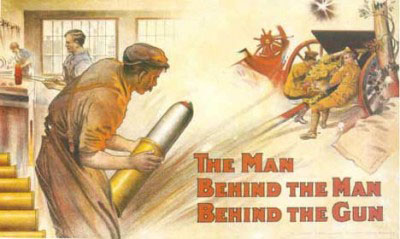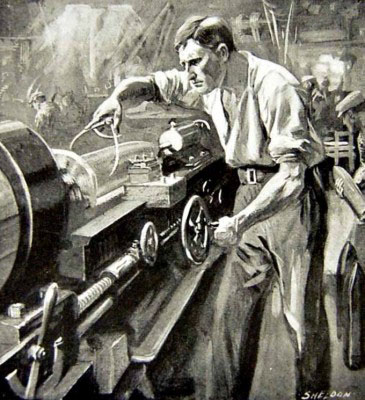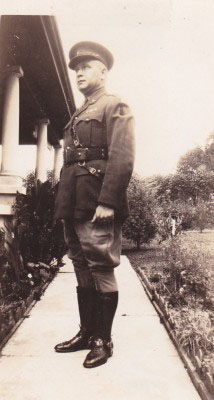In January 1917, Private Ernest Capuano, a driver with 22 AASC who has been trying to transfer to munitions work, was reporting in letters home that his unit was scheduled to go to France. He appeared resigned to going to the war zone and he had packed his kit in preparation, but as the unit began to ready itself for its move he was called to the headquarters and told to report immediately to AIF headquarters in Horseferry Road, London. There he discovered he was to be discharged from the AIF and become a munitions worker: ‘Was sent to His Majesty’s Munitions Factory at Ellesmere Port, Cheshire, England, as Works Foreman in charge of approximately 100 men…’ The appointment to Ellesmere completed the circle Capuano had begun with Professor Steele, responsible for phenol production.
About 6,000 Australians came to Britain to work in munitions factories after the great shell shortage in the battles of 1916 exposed the deficiencies in production of both armaments and military supplies of all kinds. With skilled workers being sucked into the fighting units, new workers were required – women from the British population and many men from the Dominions and the USA. Such was the demand that in August 1916, 45,000 soldiers were actually released from the British Army to for factory work.

However, historian of the munitions worker schemes, Tony Griffiths, noted:
Before the formal [Australian] Munition Workers scheme was established, two less-formal ones operated. One was initiated by a British explosives chemist, Arthur Leighton, employed in Australia to run the Maribyrnong cordite factory but loaned back to Britain for the entire war. He worked for the British Ministry and arranged for many Australian chemists, chemical engineers and associated skilled people to come to Britain. Capuano had been at Melbourne University for four years [and with the Chemistry Department at Queensland University]; it’s quite possible that he knew some of these men who then passed his name to Leighton and thus to the British Ministry. There was a shortage of all sorts of skills and the Australian experts recruited by Leighton would have known of them and, possibly, of Capuano’s presence in Britain. Leighton’s first chemical recruits left Australia in August 1915; by May 1917 there were about 100 of them, most of whom would have been in the Australian scheme. It shipped its first lot – 39 chemists – in September 1916.
This seems eminently feasible as an explanation as to how and why Capuano was released from active service in January 1917 and became a foreman at the Port Ellesmere factory in Cheshire. The factory at Port Ellesmere was part of the British Ministry of Munitions’ Department of Explosive Supply. Phenol, from which picric acid was derived, was an essential element in the production of explosives for artillery shells. Phenol also provided a connection and, in effect, a lifeline for Capuano to stay out of the fighting.
In late May 1917 Capuano, already a munitions worker, applied to become an official Australian Munitions Worker. This came about because Lieutenant-Colonel Samuel Henry Edgerton Barraclough, in charge of Australian Munitions Workers in London, had issued a Circular No 9 in May 1917 calling upon skilled men (including Australians already engaged in munitions work in England, like Capuano) to enrol for war munitions work and be registered under the Australian scheme. It was to this circular that Capuano responded. Capuano’s application, dated 24 May 1917 was approved immediately, although he was not issued with his Badge (No.1100) and certificate until 30 January 1918.
Adding strength to Griffiths’ hypothesis that Capuano was engaged initially under Leighton’s scheme, rather than Barrowclough’s, was the notation on Capuano’s enrolment application ‘Not known to me personally’, while in contrast, on his file sits a letter from the Secretary, Factories Branch of the Ministry of Munitions of War in Westminster in December 1916, which actually asks for Capuano by name – “we have been given the name of” – to be released from AIF service. Even though Capuano is given a Class A classification by the AIF, he is nonetheless released for munitions work.
Regardless of where he ended up, Capuano’s basic philosophy hadn’t changed; he was willing to do his bit but abhorred the possibility of personally becoming involved in killing. When the Australian Prime Minister, Billy Hughes, attempted a second time to have conscription passed in Australia, Capuano wrote home to say that while he thought the measure might get through, he hoped that it did not. This was a common sentiment among AIF diggers, who voted against conscription even when extra numbers of troops were desperately needed.
Although released by his new role from the spectre of fighting at the front, the work Capuano was now engaged in was nonetheless dangerous and exhausting. A small spark within the factory could have had disastrous consequences for the factory and everyone in it. In addition, Capuano worked very long hours, often working 15 hour shifts, as demand for high explosive continued to grow with the war effort.

Capuano continued his story:
While working on munitions in March 1918 I tried again to join the [A.I.F.]. On 28 March, 1918 I got a reply to say I must produce a release from munitions first. This I tried to obtain but was refused.
The factory was ordered closed in late February 1918 due to low production levels of phenol, which may explain Capuano’s subsequent request for re-enlistment in the AIF. There is no record of Capuano’s request to do so, perhaps because Ellesmere did not actually close but continued production. According to Capuano’s own letters, the factory continued producing shells even after the war had ended, presumably to build up reserve stocks once more. Capuano remained at the Port Ellesmere factory through the remainder of 1918.
The dangers of working in the environment were again brought home to his family when he reported in a letter how two local men had died, it was alleged, from poison gases which had escaped from his factory. Capuano seemed hardened to this, commenting, ‘of course this [leakage] cannot be avoided altogether as accidents will happen’. In fact Capuano himself ‘got a good dose of the gas’ in February 1919, but recovered quickly enough. By this time, he is the last of the seven Australians who had been working at the factory, and impatiently awaiting news of his ship home.
Finally, in February 1919 the news that he was waiting for – to finally cease production and start cleaning and repairing the factory. Soon after he was on his way home, arriving in Melbourne in May 1919 on the Cunard line’s steam ship Kursk. For his service in the Great War, Capuano was awarded the British War Medal in 1922. Returning to his old firm, E. A. Machin & Co., Cappuano rose to be Managing Director in the years ahead.
Capuano again enlisted in the Militia in 1930. He rose to Lieutenant and Assistant Adjutant in the 29th Infantry Battalion, based mainly about East Melbourne and part of Victoria’s 4th Militia Brigade. Capuano stated that he served under Lieutenant Colonel Edmund Frank Lind, who was the Commanding Officer in 1931 and 1932. The Great Depression which began in late 1929 curtailed training camps but 29th Battalion was at Seymour in 1930 and1931. Capuano wrote later that he was forced to resign from the Militia due to pressure of business and illness.

With the outbreak of World War II, and Italy now an enemy and not the ally as it was during the Great War, the Capuanos, despite their long residency in Australia and Scottish antecedents, found themselves subject to ‘propaganda pressure and much unpleasantness from ignorant people.’ As a result, it ‘was a great wrench’ when the family decided to change their name by deed poll to Capp. The wider family was not untouched by the war, even though they had not changed their name. Lieutenant Ernest James (‘Jim’) Capuano, a cousin, died of wounds received on active service with the 2/7th Infantry Battalion in New Guinea in 1943.
Ernest William Capp died on 23 October 1979. The somewhat contradictory period of his military service in 1915 and 1916, conflicting as it did with religious views, was nonetheless balanced by his dedication as a foreman in a large munitions factory, where he worked a punishing schedule in a highly dangerous environment over the following two years. Capuano/Capp’s story illustrates the determination of many men, although conflicted by the war in different ways, to serve their country in some worthwhile capacity. Capp’s work in munitions was every bit as vital to the war effort as the men who served in the frontlines. While his religious convictions weighed heavily on him, nonetheless Capp made a substantial personal contribution to the war effort in World War I.
About The Author.
Andrew Kilsby is an historian with Cooee History and Heritage. He is also Executive Officer of MHHV Inc. This two part article is excerpted from a longer life biography of E.W. Capp commissioned for the Capp family. It is published with permission.
Contact Andrew Kilsby about this article.






